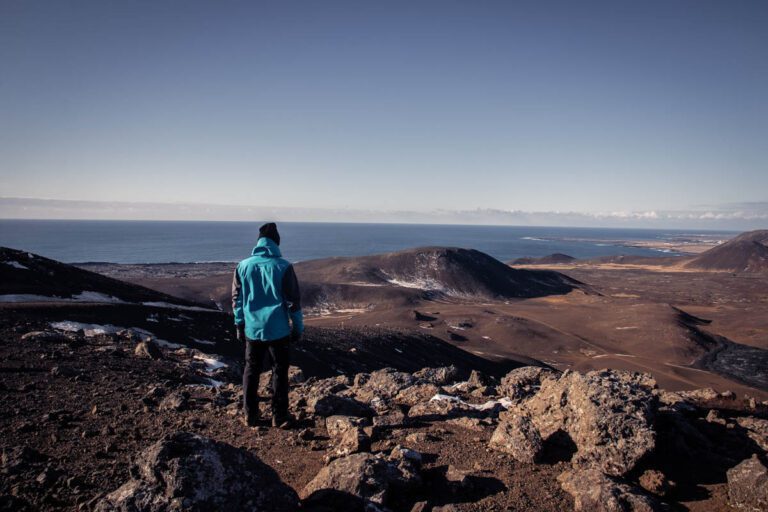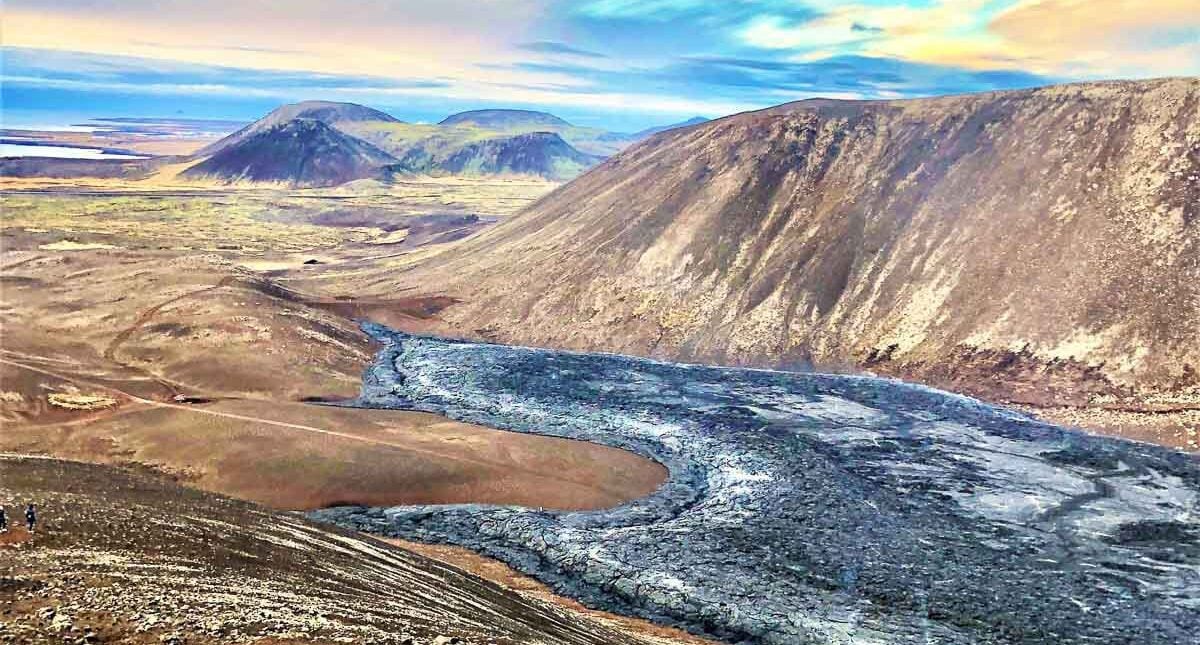

Explore Fagradalsfjall and Meradalir on our Iceland volcano tours
A wide variety of volcano tours that combine a visit to the eruption sites at Geldingargalur Valley with other must-see attractions
Reykjanes Peninsula is situated in the south-west corner of Iceland and is home to Keflavík international airport, the Blue Lagoon and Iceland’s most recently active volcanoes.
Fagradalsfjall, Meradalir and Litli-Hrutur volcano eruptions captured the world’s attention and became a destination for thousands of travelers during the last three years. And no wonder! Witnessing a live active volcano eruption or seeing newly formed landscapes is a truly profound experience.
On your journey through the Reykjanes Peninsula, you’ll be introduced to the volcanic activity that has occurred since 2021. Your guide will showcase significant spots, possibly including the most recent Sundhnúkur eruption, which commenced on December 18th, 2023, and subsided just three days afterward.
In addition to visiting the eruption sites, you can choose to relax in the Blue Lagoon geothermal spa or explore the Reykjanes peninsula highlights like Gunnuhver Hot Springs, Reykjanesviti Lighthouse, The Bridge Between Continents and more!
Join us to explore Iceland’s youngest volcanoes
Hike Geldingadalir valley with us and see the crater of Fagradalsflall volcano and cooled lava rivers from the Meradalir eruption. Take a ride around Reykjanes or soak in the Blue Lagoon after intensive but rewarding hike.
Volcano Eruptions 2021-2023 on Reykjanes Peninsula
Prior to the 2021 eruption, Fagradalsfjall was an inconspicuous mountain ridge, with elevation of less than 400 meters above sea level. It had remained inactive for a 6000 years or more. In contrast, Geldingadalur experienced an eruption around 800 years ago, being the most recent eruption on the Reykjanes Peninsula. It took place between 1210 and 1240 AD, known as the Reykjanes Fires.
Fagradalsfjall volcano eruption 2021
The Fagradalsfjall eruption, which began in March 2021, marked the start of a new era of volcanic activity on Reykjanes peninsula. This eruption showcased Iceland’s breathtaking natural beauty, with rivers of molten lava flowing from the fissure and fiery displays illuminating the night sky. Fagradalsfjall quickly became a popular hiking destination, offering visitors a rare opportunity to witness a volcanic eruption up close.
The Fagradalsfjall volcano eruption lasted for half a year, but the area remained active and continued attracting visitors joining Iceland volcano tours.

Meradalir Volcano eruption 2022
Less than a year after that, a new eruption started in Meradalir, an adjacent valley to Fagradalsfjall. After several days of frequent earthquakes, lava flow began on August 3rd 2022. Despite the fissure opening in a more remote location than Fagradalsfjall, around 2,000 people visited the eruption site on the first day!
However, the Meradalir eruption turned out to be considerably shorter than the previous one, ceasing after only 3 weeks.

Litli-Hrútur Volcano eruption 2023
To continue the tradition of Icelandic yearly volcano, another fissure opened near Litli-Hrútur on July 10th, 2023. From the start the eruption looked to be larger than the preceding ones, with a tenfold lava flow compared to Faradalsfjall.
Contrary to the predictions, the flow decreased rapidly within the first days of Litli Hrutur eruption. It continued decreasing until August 5th, when it ceased completely.

Sundhnúkur Volcano Eruption in 2023
In the ever-changing landscape of Iceland, a remarkable new volcanic eruption occurred at Sundhnúkur on December 18th at 22:17. This event marks the largest eruption in recent times on the Reykjanes Peninsula, featuring an impressive 4 km long fissure and an estimated lava flow of 250 cubic meters per second.
Remarkably, this eruption has not impacted air travel and currently poses no threat to overall safety in Iceland. However, for the immediate safety of visitors and locals, the area near the eruption site remains off-limits. Situated close to the town of Grindavik, the geothermal power plant, and the iconic Blue Lagoon, this volcanic activity has garnered significant attention. Specialists have noted that, under the circumstances, the eruption occurred in one of the best possible locations, posing no immediate danger to critical infrastructure. The lava flow would need to persist for an extended period to pose any significant risk.

As a precaution, the beloved Blue Lagoon has been temporarily closed, and Grindavik has been evacuated. As of the early morning of December 21st, the lava flow at the Sundhnúkur site has ceased, yet the region remains geologically active. There is ongoing potential for the eruption to restart or for a new fissure to emerge nearby. Visitors are advised to stay informed about the latest developments and safety guidelines as they experience the awe-inspiring power of Iceland’s volcanic landscape.

Reykjanes Peninsula: A Geothermal Wonderland
Reykjanes is a captivating region renowned for its dramatic landscapes and unique geological features. This remote and rugged area offers visitors an opportunity to explore the powerful forces of nature at work, all while being in close proximity to the capital city of Reykjavik.
Here are some of the remarkable things to see and experience on the Reykjanes Peninsula.
The Blue Lagoon
This world-famous geothermal spa is a must-visit destination. The Blue Lagoon is a surreal oasis of steaming blue waters, surrounded by lava fields. You can soak in the warm, mineral-rich waters, which are known for their healing properties, while enjoying stunning views of the surrounding landscapes.

Krýsuvík Geothermal Area
Krýsuvík is an active geothermal area filled with hot springs, fumaroles, and colorful mineral deposits. Hiking trails meander through the bubbling and hissing landscapes, providing a surreal and captivating experience.

Reykjanesviti Lighthouse
Iceland’s oldest lighthouse, Reykjanesviti, offers stunning panoramic views of the rugged coastline and North Atlantic Ocean. It’s a great place for a leisurely stroll and to admire the coastal beauty.

Gunnuhver Hot Springs
Gunnuhver is a geothermal area on the peninsula with an otherworldly appearance. You can observe bubbling mud pots and steaming hot springs that showcase the Earth’s geothermal energy in its raw form.

Kleifarvatn Lake
This serene, volcanic lake is surrounded by dramatic scenery and is one of the largest on the peninsula. The area is perfect for hiking and birdwatching, with a trail that leads to the fascinating hot springs at Seltún.

The Bridge Between Continents
The peninsula is situated along the Mid-Atlantic Ridge, which divides the North American and Eurasian tectonic plates. At the Bridge Between Continents, you can walk across a footbridge symbolizing the connection between these two massive tectonic plates. It’s a fascinating geological experience and a great photo opportunity.

The Reykjanes Peninsula is a land of stark beauty, where the earth’s geothermal energy is on full display. Whether you’re interested in geology, relaxation, or simply taking in the breathtaking landscapes, this region offers a unique and unforgettable experience for travelers exploring Iceland.
Why Choose BusTravel Iceland
BusTravel Iceland has over 60 years of experience running guided tours and over 32 thousand 5-star reviews. We have been hiking to eruption sites on Reykjanes from the start of Fagradalsfjall volcano eruption in 2021. Our guests were the first ones to see Meradalir eruption in 2022, on the day it started to erupt.
During ongoing eruptions we will get you to the closest and best possible viewing spot, taking all safety precautions. When there is no lava flow, the area remains active and fascinating. Then we hike along cooled steaming lava rivers and sleeping volcano craters.
Travelers reviews
Write a review
Share your experience with others.
Travelers reviews
Write a review
Share your experience with others.

















